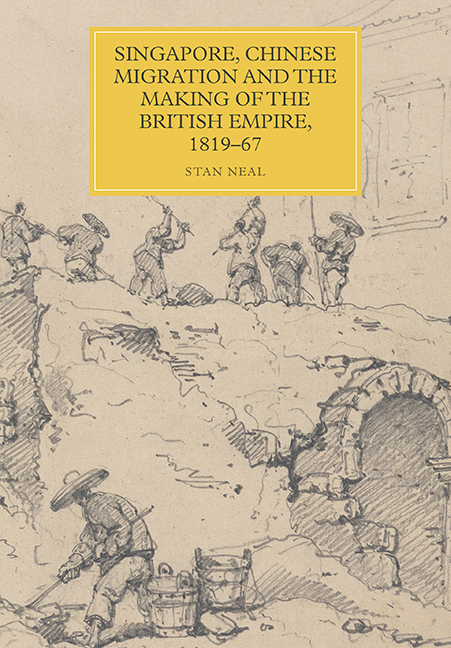Book contents
- Frontmatter
- Dedication
- Contents
- List of Illustrations
- Acknowledgements
- Language Usage
- Chronology: Singapore, the British Empire and Anglo-Chinese Relations, 1819–67
- Map
- Introduction
- Chapter 1 The Singapore Model
- Chapter 2 The Chinese Character: Race, Economics, Colonisation
- Chapter 3 Crossing the Indian Ocean: Chinese Labour in South Asia and Beyond
- Chapter 4 From Singapore to Sydney: Race, Labour and Chinese Migration to Australia
- Chapter 5 Hong Kong versus Singapore: The Dawn of Mass Migration
- Conclusion
- Bibliography
- Index
- Miscellaneous Endmatter
Chapter 4 - From Singapore to Sydney: Race, Labour and Chinese Migration to Australia
Published online by Cambridge University Press: 26 June 2019
- Frontmatter
- Dedication
- Contents
- List of Illustrations
- Acknowledgements
- Language Usage
- Chronology: Singapore, the British Empire and Anglo-Chinese Relations, 1819–67
- Map
- Introduction
- Chapter 1 The Singapore Model
- Chapter 2 The Chinese Character: Race, Economics, Colonisation
- Chapter 3 Crossing the Indian Ocean: Chinese Labour in South Asia and Beyond
- Chapter 4 From Singapore to Sydney: Race, Labour and Chinese Migration to Australia
- Chapter 5 Hong Kong versus Singapore: The Dawn of Mass Migration
- Conclusion
- Bibliography
- Index
- Miscellaneous Endmatter
Summary
From the 1830s onwards various British colonies struggled with labour shortages, but there was one continent where this issue of labour coincided with racial anxieties and explicit racial prejudice: Australia. The development of Indian Ocean colonies, which relied on Asian indentured labour over the nineteenth century, has been characterised as a separate process from the development of Britain's white settler colonies. This chapter demonstrates how the colonial model of Singapore influenced Chinese migration, and discussions about Chinese migrants, in Australia. Again, the Australian example demonstrates the importance of wider imperial changes in the demand for labour and debates about racial hierarchy. The suspension of convict transportation to New South Wales in 1840 exacerbated pre-existing labour shortages, which created demand for Chinese migrant labour. In New South Wales, there was a broader interest in using cheap Asian labour to address labour shortages. Tony Ohlsson and Rose Cullen have examined how debates over the introduction of indentured labour from India fed into broader anxieties about race and labour in colonial New South Wales. This chapter examines the use of Chinese migrant labour in this context of labour shortages and white settler opposition to Asian immigration.
The proposed Chinese immigration schemes stoked developing racial anxieties amongst the white settler population. There is a wealth of literature on Chinese exclusion in Australia in the context of racist anti-immigration movements across the white settler colonies of the British Empire and the United States of America. Histories of exclusion focus on the second half of the nineteenth century as political and economic turmoil in southern China and the prospect of gold in Australia and California stimulated mass migrations. An estimated 55,000 Chinese migrants left China for Australian colonies between 1851 and 1875. In response, over the second half of the nineteenth century Australian colonies introduced a series of immigration controls aimed at restricting Chinese immigration. This culminated in the Immigration Restriction Act (1901) as the first policy of the newly federated Australia. The dominant explanation for proliferation of immigration controls in colonial Australia is that negative racial stereotypes were popularised in response to mass migrations from China. Critics of Chinese immigration presented the Chinese as a social and economic threat to white settler society. We can see this pattern of an exclusionary response to immigrants, based on negative stereotypes, in the present day.
- Type
- Chapter
- Information
- Publisher: Boydell & BrewerPrint publication year: 2019



